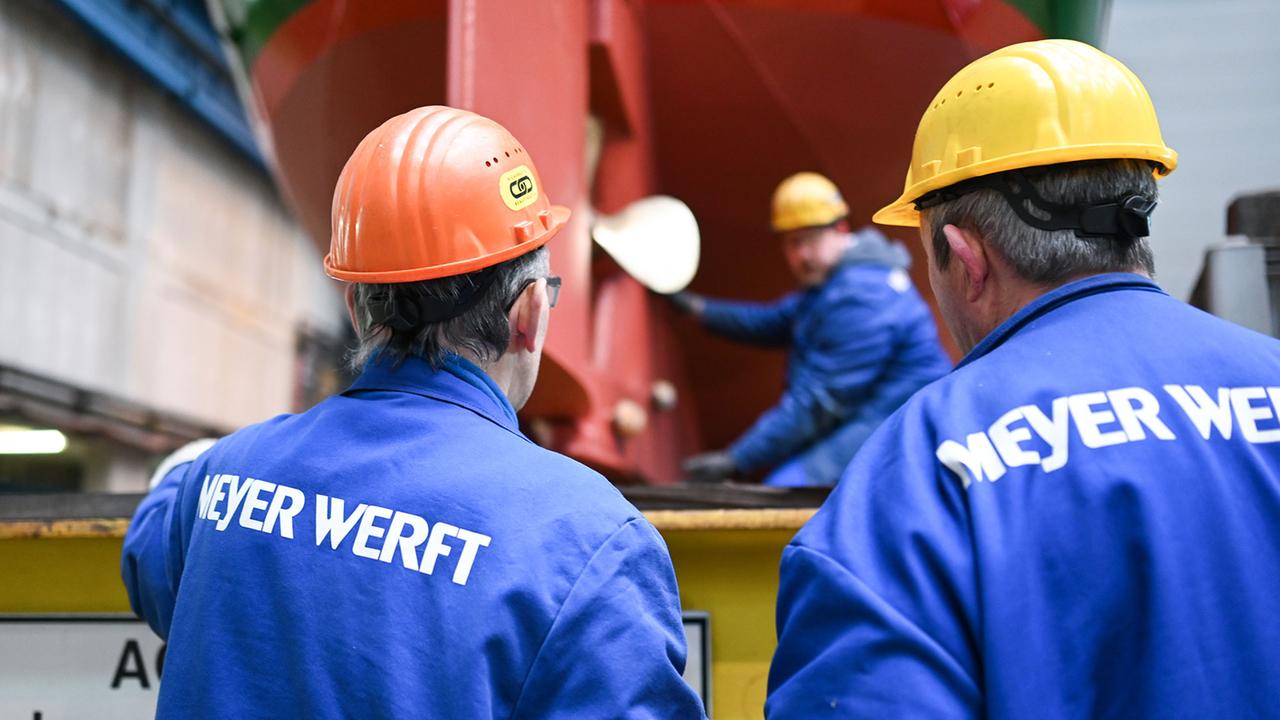analysis
Chancellor Scholz wants to save Meyer Werft by taking state ownership – and even calls the luxury shipbuilder systemically important. But how important can a cruise company really be?
Meyer Werft, with headquarters in Papenburg, Lower Saxony, has been building boats for 228 years: first wooden sailing ships, later iron tugs, and now the company has specialized in luxury cruise ships. The shipbuilder has repeatedly defied crises and adapted to new requirements.
But recently, despite all its adaptability, the traditional company was on the brink of collapse. The company was faced with not just one challenge, but several crises: First, demand for the floating luxury holiday resorts collapsed during the pandemic. Then the prices for energy and raw materials exploded. The company recently puts its financing gap at 2.7 billion euros.
One Luxury liner shipyard becomes a state-owned company for a limited period
On Thursday, Chancellor Olaf Scholz (SPD) promised on behalf of the federal government and Lower Saxony's Prime Minister Stephan Weil (SPD) to save the company by having the state participate until 2027. “The federal government is doing its part to find a solution,” Scholz told some of the workforce. And he praised Meyer Werft by describing it as systemically important for the maritime economy.
In the past, the German state has repeatedly invested in struggling companies: examples include Commerzbank, Opel, TUI and Lufthansa. At the time, it was sometimes argued that these companies were systemically important.
This is what the rescue should look like
Internal sources say that the federal government and the state of Lower Saxony will not only guarantee around 900 million euros each, but will also take over a majority stake of 80 to 90 percent in the shipyard. There is talk that the federal government and the state will increase equity by around 400 million euros. This would make Meyer Werft a state-owned company until 2027.
Why does the state save a Private companies?
But how systemically relevant can cruise ships be? Although Meyer Werft delivered components for a naval tanker for the first time this year and continues to build exploration ships for research, the company's main focus is on luxury liners for tourism purposes.
Ifo President Clemens Fuest is critical of state aid: “It is not the state's job to save struggling private companies from bankruptcy,” the head of the Munich-based economic research institute told the Reuters news agency. The fact that Meyer also builds warships could at best justify supporting this part of the shipyard – but not promoting the production of cruise ships.
“State bailouts can only be justified in situations of macroeconomic crises in which capital markets are disrupted,” said Fuest. But that is not the case at the moment. Otherwise, he judges: “If the business model is promising, private investors will be found.”
Central motive: securing jobs
Economist Max Johns from the Hamburg School of Business Administration also pointed out dailynews24 Clear: Saving the Meyer Werft is not about questions of national security. “Germany would survive very well, even without such a shipyard.”
But there is more than just this reason for state involvement, says the shipping industry expert: “The state can sensibly get involved for three reasons: to secure jobs, technology or the country's security.” In Meyer's case, he sees point three as a given: to secure jobs.
Shipbuilding has strong domestic value creation
More than 3,000 employees continue to work at the Papenburg site alone. The jobs are also relatively well paid, as the company pays according to the collective agreement. In an otherwise structurally weak area, this is an enormous economic factor.
In addition, there are thousands of other jobs that depend on the shipyard in Germany and the region. The shipbuilding industry traditionally relies heavily on domestic suppliers. The Association for Shipbuilding and Marine Technology (VSM) estimates that the share of domestic German value creation in the shipbuilding industry is more than 70 percent.
Lower Saxony's Prime Minister Weil said that 17,000 jobs across Germany were at stake, which directly or indirectly depended on the continued existence of Meyer Werft.
Economist: Shipyard can get back on its feet through state intervention
Economics professor Johns believes that the investment could be worthwhile: “The company is well positioned. The order book is well filled and has been for the past few years. In addition, there have been many modernizations here in recent years.” It is not the fault of the company or the workers that there is currently a crisis.
The problem is rather a financing gap: The pandemic has hit the cruise industry hard worldwide. Then came the rising prices.” In addition, there is a specific constellation in the shipbuilding industry, as the shipyards usually pay around 80 percent in advance. “If this bridging is provided, I believe that the shipyard can become profitable again.
According to information from Meyer Werft in August, the order book currently includes ten cruise ships, a research vessel and the steel construction of four offshore converter platforms with a total value of eleven billion euros.
Increasing demand for cruises
Tailwind is also coming from a significant increase in demand for cruises. According to the Cruise Lines International Association (CLIA), almost 31 million people took a cruise last year. That is seven percent more than in 2019, the year before the pandemic. Experts assume that interest in these trips is likely to grow even further.
After the USA, the most important sales market for cruises worldwide is Germany. According to CLIA, 2.5 million people in this country spent their holidays on deck last year.
Economist Rudolf Hickel from the University of Bremen stresses dailynews24that the Meyer Werft plays a central role worldwide in the construction of luxury liners: “Apart from France and Italy, nothing like this is built in any other country in the world.” In Asia, personnel costs may be cheaper, but such boats cannot be built there. One reason is that there is a strong supplier industry in Germany.
There must not be another crisis
However, Johns also says: “We must not allow another crisis to intervene.” He sees a risk as a collapse in demand due to wars, recessions or a new pandemic.
And whether there absolutely has to be a German cruise ship builder in the long term or whether a merger with another shipyard would be an option is another matter. “You don't necessarily have to keep a crown jewel in the country, we are not a monarchy.” However, the prerequisite is that the German locations are retained.
And that is precisely why the bridging aid from the state is now an opportunity. Johns: “The state investments that are now coming in would make such discussions possible in the first place.”




